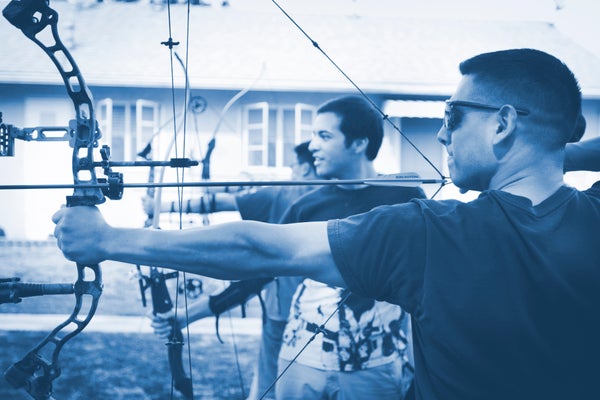“Like an expert singer skilled at lyre and song—who strains a string to a new peg with ease, making the pliant sheep-gut fast at either end—so with his virtuoso ease Odysseus strung his mighty bow. Quickly his right hand plucked the string to test its pitch and under his touch it sang out clear and sharp as a swallow’s cry.”
As Homer so dramatically noted nearly three millennia ago, archers must possess both muscle and skill, but bow technology has changed dramatically since Odysseus’s triumphant return to Ithaca. That change is now fueling a debate about whether or not to add a new event—compound archery—to the games that began around the same time in ancient Greece.
Currently recurve bows—which resemble the Homeric variety and require considerably more strength and finesse to shoot than compound bows—are the only type permitted in Olympic competition. Yet the number of elite compound archers worldwide is now growing as compound bow technology becomes less expensive and more widely tested in international competitions. With its expanding popularity, some archery aficionados say it’s only a matter of time until compound archery snags a spot in the Games. “We represent all types of archery, and compound archery we see as the same level of competition as recurve archery,” says Tom Dielen*, secretary general of the World Archery Federation, the sport’s international governing body, which advocates for compound archery’s inclusion in the Olympics. “In athletics, you can have different types of competitions within the same sport on the same level, like Olympic indoor and Olympic beach volleyball.”
On supporting science journalism
If you're enjoying this article, consider supporting our award-winning journalism by subscribing. By purchasing a subscription you are helping to ensure the future of impactful stories about the discoveries and ideas shaping our world today.
In order for the International Olympic Committee (IOC) to consider adding a new event to its roster, the event must be distinct from other Olympic events. Competitive compound and recurve archery differ technically and also procedurally, with different point systems and rules used in each country. Compound archers generally shoot at a six-ring target with a diameter of 80 centimeters from a distance of 50 meters whereas recurve archers shoot at a 10-ring target with a diameter of 122 centimeters from a distance of 70 meters.
Another factor the IOC considers when evaluating a new event is whether the athletes—not their equipment—are scoring the points and setting records, Dielen says. That is technologically where compound and recurve archery deviate most. Compound bows have a mechanical release aid that assumes some of a bow’s draw weight and also come with a magnified scope, which together make the sport less about physical power and more about shooting accuracy. Recurve bows are more about a complete performance, requiring more physical strength to pull back and hold the string until the arrow is shot.
Recurve shooters must also take into account the archer’s paradox, or the phenomenon that arrows take a curved and undulating path through the air after leaving the bow. This requires skill on the part of the archers, as they need to shoot slightly off to one side in order to hit their target. “The compound bow is a much more efficient system,” says American recurve archer Zach Garrett, who will represent the U.S. at the upcoming Rio Games. “You don’t have to worry about how you make the string leave the arrow.”
Even if the IOC decides compound archery is distinct and physically rigorous enough to qualify as a new event, cost also weighs on its decision. Each additional event adds to the cost of hosting the Games. The total cost of this year’s Games may exceed the IOC’s projected $13.2-billion price tag.
The biggest hurdle the sport faces may be accessibility, however. Compound archery is more popular in Western countries than Asia, Africa and Oceania, where the technology is less readily available. This can put some countries at a competitive advantage as they benefit from a wider athlete pool that’s been able to train and compete using compound bows. “Globally, there are three competitive compound archers for every seven competitive recurve archers,” says Sheri Rhodes, national events manager of USA Archery, the American organization affiliated with World Archery. “Yet, among our members there are four compound archers for every six recurve archers.”
World Archery and USA Archery are working to give compound archery the best possible shot of becoming a new Olympic event, which Dielen and Rhodes both predict could happen as early as 2024. Internationally, World Archery is working to increase the compound archery athlete pool by attracting more women to the sport, mainly by equalizing male and female prize money at competitions and hosting more international competitions.
“It’s up to us to make sure compound archery is worthy of being in the Olympic Games,” Dielen says. “If we succeed, that will mean more medals for archers of all kinds, and more medals looks good for everyone.”
Editor's note: This story has been updated to correct the references to Tom Dielen, whose quotes were incorrectly attributed to a World Archery Federation spokesman, Chris Wells.
